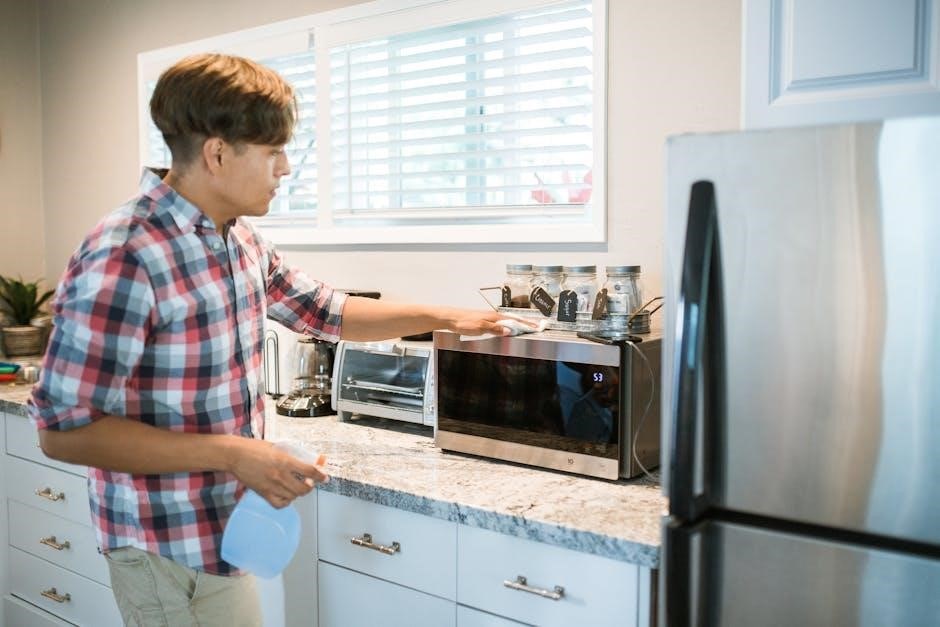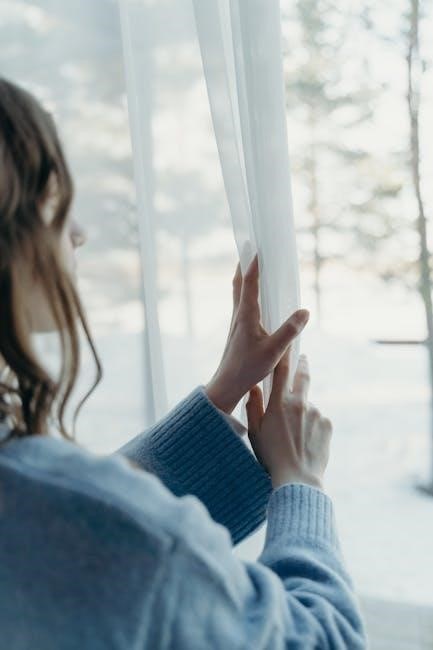E-Cloth window cloths offer a chemical-free, eco-friendly solution for streak-free window cleaning. Durable and reusable, they work with water or vinegar for a sparkling finish.
What is an E-Cloth?
An E-Cloth is a reusable, machine-washable cleaning cloth designed for effective cleaning without chemicals. Made from ultra-fine microfibers, it is ideal for windows, leaving a lint-free, streak-free finish. Unlike traditional cloths, E-Cloths are durable and can be used with just water or a small amount of vinegar for sparkling results. Their unique weave traps dirt and grime efficiently, making them a popular choice for eco-conscious cleaning. With proper care, an E-Cloth can last for hundreds of washes, providing long-term value and reducing waste.
Benefits of Using E-Cloth for Window Cleaning
Using an E-Cloth for window cleaning offers numerous benefits, including a chemical-free and eco-friendly solution; The ultra-fine microfiber effectively traps dirt and grime, leaving windows streak-free and sparkling. Unlike paper towels, E-Cloths are reusable and machine-washable, making them a cost-effective and sustainable option. They work well with just water or a small amount of vinegar, eliminating the need for harsh chemicals. This method is gentle on surfaces, reduces waste, and provides a lint-free finish, making it ideal for both residential and commercial use. The durability of E-Cloths ensures long-term performance with proper care.
Importance of Proper Window Cleaning Techniques
Proper window cleaning techniques ensure streak-free, clear results and maintain the integrity of your windows. Using the right methods prevents grime buildup, which can damage glass over time. Techniques like dampening the cloth adequately and wiping in consistent strokes minimize streaks. Avoiding excessive water prevents mineral spots, especially in hard water areas. Regular cleaning stops dirt from becoming stubborn, making the process easier. Proper techniques also extend the life of your E-Cloth by preventing residue accumulation. This approach ensures a professional finish, enhances visibility, and maintains the eco-friendly benefits of using an E-Cloth for a sparkling, chemical-free shine.

Materials Needed for E-Cloth Window Cleaning
An E-Cloth window cloth, water, and optionally, white vinegar or a squeegee, are essential for effective, streak-free window cleaning with minimal effort and eco-friendly results.

E-Cloth Window Cloth
The E-Cloth window cloth is a premium, lint-free microfiber cloth designed specifically for cleaning glass surfaces. It is highly effective at removing dirt, grime, and water spots without leaving streaks or residue. Unlike traditional cloths, the E-Cloth is machine washable and reusable hundreds of times, making it a sustainable and cost-effective option. Its unique microfiber structure traps dirt and moisture efficiently, ensuring a sparkling finish with just water. For best results, use it damp but not soaking wet, as excess moisture can lead to streaks. Regular washing maintains its effectiveness and extends its lifespan.
Water
Water is a key component for effective window cleaning with an E-Cloth. Use distilled or filtered water to avoid mineral spots, especially in hard water areas. Dampen the cloth thoroughly but avoid soaking it, as excess water can lead to streaks. For best results, use room-temperature water, as it helps the cloth glide smoothly across the glass. If desired, mix a small amount of white vinegar with water for extra cleaning power. Ensure the cloth is damp but not dripping before applying it to the window for a streak-free finish. Proper water usage enhances the cloth’s performance and cleaning efficiency.
Optional: White Vinegar
White vinegar is a natural and effective additive for enhancing your E-Cloth window cleaning experience. Mix 1-2 tablespoons of white vinegar with water in a bucket or spray bottle. This solution helps break down dirt and grime more effectively, leaving windows with a sparkling finish. Vinegar also acts as a natural degreaser, making it ideal for tackling stubborn streaks or residue. For best results, use distilled water to prevent mineral spots. Avoid using too much vinegar, as it may leave a faint scent. This eco-friendly option is a great alternative to chemical-based cleaners, ensuring a safe and streak-free result.
Optional: Squeegee or Rubber Blade
A squeegee or rubber blade can complement your E-Cloth window cleaning routine. Use it to remove excess water from the glass after wiping with the cloth. This helps prevent streaks and ensures a smoother finish. For best results, use horizontal strokes and apply gentle pressure. Replace the rubber blade regularly to maintain effectiveness. If using a squeegee, ensure it’s clean and dry before use. This tool is particularly useful for large windows or for those who prefer a traditional cleaning method alongside the E-Cloth. It enhances the cleaning process, leaving windows crystal clear and streak-free.
Step-by-Step Instructions for Using E-Cloth on Windows
Follow these steps for effective window cleaning with E-Cloth: dampen the cloth, clean the window, remove streaks, dry thoroughly, and optionally use vinegar for shine.
Preparation: Dampening the E-Cloth
Start by dampening the E-Cloth with clean water. For hard water areas, use distilled water to avoid mineral spots. Gently wring out excess moisture to prevent dripping. If desired, add a small amount of white vinegar to the water for extra shine. Ensure the cloth is damp but not soaking wet, as excess water can lead to streaks. Avoid using hot water, as it may damage the cloth or leave residue. Properly prepared, the E-Cloth is ready to effectively clean windows without chemicals, ensuring a streak-free result.
Cleaning the Window: Basic Technique
Start at the top of the window and work downward using horizontal strokes. Apply gentle pressure, ensuring even coverage. For the bottom half, switch to vertical strokes to prevent water from dripping onto the sill. Use one continuous wipe per stroke to avoid streaks. Fold the cloth to reveal a clean side and repeat as needed. For stubborn spots, increase pressure slightly but avoid scrubbing too hard. If using vinegar, the solution will help break down dirt for a shinier finish. This method ensures a clean, residue-free window with minimal effort.
Handling Stubborn Streaks or Spots
For stubborn streaks or spots, dampen a clean section of the E-Cloth and apply gentle yet firm pressure. Use circular motions to target the area. If streaks persist, mix a small amount of white vinegar with water and dampen the cloth again. Wipe the spot thoroughly, then rinse the cloth and wipe clean. Avoid scrubbing too hard, as this may scratch the glass. Repeat if necessary until the streak or spot is removed. This method ensures a smooth, even finish without leaving residue or marks behind.
Drying the Window for a Streak-Free Finish
After cleaning, use a dry section of the E-Cloth to wipe the window horizontally, starting from the top. This removes excess moisture and prevents drips. For a flawless finish, use a clean, dry microfiber cloth to wipe the glass again, ensuring no water spots remain. Avoid drying in direct sunlight, as it can cause water spots to form. For windows in hard water areas, consider using distilled water to prevent mineral residue. Proper drying ensures a crystal-clear, streak-free result, enhancing the effectiveness of the E-Cloth cleaning method.
Optional: Using Vinegar for Extra Shine
For an extra shine, mix 1 part white vinegar with 2 parts water. Dampen the E-Cloth with this solution and clean the window as usual. The acid in vinegar helps break down dirt and prevents streaks. It’s especially effective for windows in hard water areas, as it reduces mineral residue. After cleaning, use a dry section of the cloth to wipe away excess moisture. Vinegar is eco-friendly and cost-effective, making it a great addition to your E-Cloth cleaning routine for sparkling, streak-free windows without chemical cleaners.
Maintenance and Care of E-Cloth
Regularly wash the E-Cloth with mild detergent, avoiding fabric softeners. Reshape while damp and store in a dry place. Replace when worn or less effective.
Washing the E-Cloth
Wash the E-Cloth regularly with mild detergent and warm water to maintain its effectiveness. Avoid using fabric softeners or bleach, as they can reduce its absorbency. For tough stains, gently scrub the cloth before rinsing thoroughly. Reshape the cloth while damp to prevent shrinkage. Allow it to air-dry completely, preferably away from direct sunlight. For optimal performance, wash the cloth after every few uses. If using vinegar, a diluted solution can help remove residue. Replace the cloth annually or when it shows signs of wear, such as fraying or reduced cleaning efficiency.
Storing the E-Cloth
Store the E-Cloth in a dry, cool place away from direct sunlight to maintain its quality. Avoid leaving it in damp or humid environments, as this can encourage mold growth. Do not store the cloth in cleaning solutions or chemicals, as this may damage the fibers. Keep it separate from other cleaning tools to prevent cross-contamination. For extended storage, ensure the cloth is completely dry and reshape it to its original form to prevent shrinkage. Avoid using fabric softeners or hot water, as they can reduce the cloth’s effectiveness over time. Proper storage ensures the E-Cloth remains in optimal condition for future use.
When to Replace the E-Cloth
Replace the E-Cloth when it shows visible signs of wear, such as fraying edges or reduced absorbency. If the cloth no longer effectively removes streaks or dirt, it’s time for a replacement. Typically, with proper care, an E-Cloth can last for several years. However, if it becomes discolored, develops holes, or loses its texture, it should be replaced to maintain cleaning efficiency. Regularly washing and storing the cloth correctly can extend its lifespan, but eventually, replacement is necessary to ensure optimal cleaning results.
Troubleshooting Common Issues

Troubleshooting common issues with E-Cloth window cleaning involves identifying streaks, residue, or reduced effectiveness. Adjust water usage, clean the cloth regularly, and ensure proper drying for optimal results.
Why You Might See Streaks
Streaks on windows when using E-Cloth can occur due to excess water, insufficient wiping, or improper cloth preparation. Using too much water may leave residue, while too little can cause dragging. Additionally, not cleaning the cloth regularly or using it when it’s overly soiled can transfer dirt back onto the glass. Over-aggressive wiping motions may also push dirt particles across the surface instead of removing them, leading to streaks. Ensuring the cloth is properly dampened and cleaned can help minimize these issues for a clearer finish.
Removing Residue from the Cloth
Regularly washing your E-Cloth is essential to remove dirt and residue. Use mild detergent without fabric softeners, as they can reduce the cloth’s effectiveness. Wash the cloth separately from other laundry to prevent cross-contamination of dirt. For tough residue, soak the cloth in warm water with a small amount of vinegar before washing. Avoid using bleach or harsh chemicals, as they can damage the fibers. After washing, rinse thoroughly and allow the cloth to air dry. Proper maintenance ensures the E-Cloth remains effective for streak-free window cleaning and extends its lifespan.
Reusing the Cloth Effectively
To reuse your E-Cloth effectively, ensure it is thoroughly washed after each use. Use mild detergent without fabric softeners, as they can reduce the cloth’s absorbency. Avoid bleach or harsh chemicals, as they can damage the fibers. After washing, allow the cloth to air dry rather than using a dryer, which can degrade the material. Regular reuse is cost-effective and eco-friendly, as the cloth can be washed hundreds of times. Proper care ensures the E-Cloth remains effective for streak-free cleaning and extends its lifespan, making it a sustainable choice for window maintenance.
Safety Tips for Window Cleaning
- Always use a sturdy ladder and ensure it is secured.
- Wear gloves for better grip and to prevent cuts.
- Avoid cleaning windows in direct sunlight to prevent slipping.
- Keep the area around the ladder clear to avoid tripping.
- Never use harsh chemicals that could harm skin or surfaces.
Precautions When Using Ladders
When using ladders for window cleaning, ensure the ladder is placed on a firm, level surface. Always inspect the ladder for damage before use. Maintain three points of contact with the ladder—either two hands and one foot or two feet and one hand. Avoid overreaching; instead, move the ladder to a safe position. Wear non-slip shoes and avoid using ladders in wet or slippery conditions. Never lean over the side of the ladder beyond the recommended angle. If possible, have someone hold the ladder for added stability. Always descend facing the ladder and never leave it unattended.
Safe Handling of Cleaning Tools
Always handle cleaning tools with care to ensure safety and effectiveness. Wear gloves to protect your hands from harsh chemicals or rough surfaces. Keep tools clean and dry to prevent the growth of bacteria or mold. Store cleaning supplies in a secure, out-of-reach location, especially if children or pets are present. Regularly inspect tools for damage and replace them when necessary. Avoid using damaged or worn-out tools, as they may lead to accidents or ineffective cleaning. Properly dispose of any broken or unusable items to maintain a safe environment.

Eco-Friendliness of E-Cloth
E-Cloths are reusable, chemical-free, and sustainable, reducing the need for paper towels and harsh cleaners. They promote eco-friendly cleaning by minimizing waste and avoiding harmful substances.

Chemical-Free Cleaning
E-Cloths eliminate the need for chemical-based cleaners, making them a healthier choice for families and the environment. Using only water or vinegar, they effectively clean windows without harmful substances. The microfiber technology lifts dirt mechanically, ensuring a streak-free finish. This method is ideal for those seeking eco-friendly solutions, as it reduces chemical exposure and minimizes waste. Additionally, the reusable nature of E-Cloths makes them a cost-effective alternative to disposable products. By avoiding chemicals, E-Cloths promote safer cleaning practices, especially for homes with pets or children, while maintaining superior cleaning results.
Sustainability of E-Cloth
E-Cloths are a sustainable choice for window cleaning, reducing environmental impact by eliminating the need for paper towels and chemical sprays. Their reusable design minimizes waste, as one cloth can be washed and used hundreds of times. Made from durable microfiber, E-Cloths last longer than traditional cleaning tools, reducing the frequency of replacements. By using water or vinegar, they avoid harmful chemicals, promoting eco-friendly cleaning practices. This makes E-Cloths an excellent option for those prioritizing environmental conservation and reducing their carbon footprint while maintaining effective cleaning results.

Cost-Effectiveness of E-Cloth
E-Cloths are a cost-effective option for window cleaning, offering long-term savings by reducing the need for disposable products and chemical-based cleaners, making them a budget-friendly choice.
Long-Term Savings
E-Cloths provide significant long-term savings by eliminating the need for disposable paper towels and chemical-based cleaners. Their durability and reusability mean they can be washed and reused hundreds of times, reducing recurring expenses. Additionally, E-Cloths work effectively with just water or a small amount of vinegar, minimizing the cost of cleaning solutions. Over time, this eco-friendly approach not only saves money but also reduces waste, making it a cost-effective and sustainable choice for window cleaning. The initial investment in an E-Cloth pays off through years of reliable use and maintenance.
Comparison to Traditional Cleaning Methods
E-Cloths outperform traditional methods like paper towels and chemical sprays by offering a reusable, eco-friendly alternative. Unlike paper towels, which create waste and streaks, E-Cloths leave windows spotless with just water. They eliminate the need for chemical-based cleaners, reducing costs and environmental impact. E-Cloths are also more durable than microfiber cloths, maintaining their effectiveness after multiple washes. This makes them a superior choice for those seeking a sustainable, cost-effective, and streak-free window cleaning solution that surpasses conventional methods in both performance and longevity.
Comparing E-Cloth to Other Window Cleaning Methods
E-Cloth excels over paper towels and chemical sprays by being reusable, eco-friendly, and cost-effective. It eliminates streaks and reduces waste, offering a superior cleaning experience.
E-Cloth vs; Paper Towels
E-Cloth is a superior choice compared to paper towels for window cleaning. Unlike paper towels, which are single-use and create waste, E-Cloth is reusable and eco-friendly. It effectively removes dirt and streaks without leaving lint or residue, offering a cleaner finish. Paper towels often require chemical cleaners, while E-Cloth works perfectly with just water or vinegar, making it a more sustainable option. Over time, E-Cloth saves money and reduces environmental impact, making it a practical and efficient alternative for window cleaning tasks.
E-Cloth vs; Chemical-Based Sprays
E-Cloth stands out as a chemical-free alternative to traditional sprays, offering a safer and more eco-friendly cleaning solution. Unlike chemical-based sprays, which can leave residues and harmful fumes, E-Cloth uses only water or vinegar to achieve a streak-free finish. It is reusable and durable, reducing waste and long-term costs. Chemical sprays often require repeated applications and can damage surfaces over time, while E-Cloth remains gentle and effective; This makes E-Cloth a healthier choice for families and pets, promoting sustainability without compromising on cleaning efficiency.
E-Cloth vs. Microfiber Cloths
E-Cloth and microfiber cloths are both popular for window cleaning, but they differ in performance. E-Cloth is lint-free and designed specifically for streak-free results, often outperforming microfiber in this regard. While microfiber cloths are soft and effective, they may leave behind lint or require chemical sprays for optimal results. E-Cloth, on the other hand, works perfectly with just water, making it a more eco-friendly option. Both are reusable and durable, but E-Cloth’s unique fiber structure ensures a cleaner finish without the need for additional products, giving it an edge for those seeking a chemical-free solution.

Frequently Asked Questions
Common questions include whether E-Cloth can be used on other surfaces, how often windows should be cleaned, and if E-Cloth is better than glass cleaners.
Can E-Cloth Be Used on Other Surfaces?
E-Cloth is versatile and can be used on mirrors, countertops, and electronics. It works well on glass, stainless steel, and wood surfaces. For best results, dampen the cloth lightly and avoid using harsh chemicals. Regular washing maintains its effectiveness. While suitable for most surfaces, avoid abrasive materials that might damage the cloth. This makes E-Cloth a practical tool for various cleaning tasks beyond windows, ensuring a chemical-free and eco-friendly solution for your home.
How Often Should I Clean My Windows?
Windows should be cleaned every 1-2 months, depending on weather conditions and location. Areas with high dust or pollen may require more frequent cleaning. For maintenance, wipe windows weekly with a damp E-Cloth to prevent streaks and buildup. Regular cleaning ensures clarity and reduces the need for deep cleaning. Adjust frequency based on visibility and outdoor activities. Consistent cleaning with E-Cloth maintains a sparkling appearance and prolongs glass health. This routine also prevents stubborn stains, making future cleaning easier and more effective.
Is E-Cloth Better Than Glass Cleaners?
E-Cloth is often considered better than traditional glass cleaners due to its chemical-free, eco-friendly design. It uses only water or vinegar, eliminating harsh chemicals and reducing environmental impact. Unlike glass cleaners, E-Cloth is reusable and durable, making it a cost-effective option. It also leaves no residue or streaks, providing a clearer finish. For those prioritizing sustainability and effectiveness, E-Cloth is a superior choice. It’s ideal for eco-conscious users seeking a reliable, long-term cleaning solution without the drawbacks of chemical-based products.
In conclusion, E-Cloth window cloths provide an effective, eco-friendly, and cost-efficient solution for cleaning windows. Their chemical-free design, combined with reusability, makes them a sustainable choice for maintaining streak-free glass surfaces. By following the instructions and proper care, E-Cloth can be a long-lasting tool in your cleaning arsenal. For those seeking a reliable and environmentally conscious method, E-Cloth is an excellent alternative to traditional glass cleaners. Embrace this innovative approach to keep your windows sparkling while reducing your environmental footprint.

Additional Resources
For further guidance, refer to the Manufacturer’s Guide for E-Cloth and explore Video Tutorials for Window Cleaning to master techniques and maintain your cloth effectively.

Manufacturer’s Guide for E-Cloth
The official Manufacturer’s Guide for E-Cloth provides detailed instructions for optimal use and care. It covers materials needed, step-by-step cleaning techniques, and troubleshooting tips. The guide emphasizes eco-friendly practices, such as using water or vinegar, and explains how to maintain the cloth’s effectiveness. It also includes safety precautions and advice on when to replace the cloth. By following the guide, users can achieve streak-free windows while extending the cloth’s lifespan. This resource ensures you maximize the benefits of your E-Cloth for a sustainable and cost-effective cleaning experience.
Video Tutorials for Window Cleaning
Video tutorials provide visual guidance for using E-Cloth effectively. They demonstrate techniques like dampening the cloth, cleaning windows in sections, and drying for a streak-free finish. Many tutorials also cover troubleshooting tips, such as removing stubborn streaks or residue. These videos often highlight eco-friendly methods, like using vinegar, and offer maintenance advice to prolong the cloth’s lifespan. By watching these tutorials, users can master the E-Cloth window cleaning process and achieve professional-like results at home. They are an excellent resource for both beginners and experienced users seeking to optimize their cleaning routine.